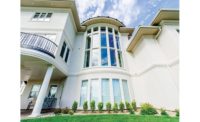When you think about the Canadian landscape, a desert may not immediately come to mind. But the British Columbia interior is an area known for its desert-like climate. The weather conditions include high winds, and while rainfall is typically low, it has been slowly increasing over the years.
Valleyview Secondary School is located in this region, in the city of Kamloops. When the school required a new structure to house critical areas of study including tech labs, home economic workshops, AV rooms, and more, a 68,000-square-foot addition needed to be built onto the existing 75,000-square-foot facility. Beyond offering additional space, it was imperative that the new structure would hold strong against punishing winds and potentially invasive moisture.
A team was gathered ahead of the project to include architect Station One Architects; general contractor Dawson Wallace Construction Ltd.; envelope consultants CSA Building Sciences Western Ltd.; and LAPC Drywall Ltd.
Choosing the Right Materials
The building team needed to find the right materials that would not only withstand windy conditions and increasing rain, but also boost efficiency on the jobsite, since the rush was on to finish before the school year began.
The team wanted to best protect the building envelope with a water-resistive barrier and air barrier (WRB/AB), along with a quick and easy installation. So they decided on Georgia-Pacific’s DensElement Barrier System.
The barrier system streamlines installation of the building envelope with an integrated gypsum sheathing that also acts as a water-resistive barrier and an air barrier. These products were designed to protect against air leakage and water intrusion by preventing water and air leakage at the seams, fasteners, rough openings, and distinct transitions to other surfaces.
Station One Architects, specialists in the education design segment, recommended the system due specifically to its stellar reputation. This feeling was echoed by the project’s envelope consultant, Paul Surgeson at CSA Building Sciences Western Ltd., who vetted and approved the barrier system. He was impressed by the data sheets, the specifications, and the materials’ ability to resist moisture and wind. As a result, he pushed the products forward with confidence as a method to speed up construction. Dawson Wallace Construction Ltd., the general contracting firm on the job, also praised the products for making the building watertight more quickly, saving time on installation without incurring additional costs.
 DensElement Barrier System protects against air leakage and water intrusion, and installs quickly and easily.
DensElement Barrier System protects against air leakage and water intrusion, and installs quickly and easily.
A Glowing Report Card
The school’s structure consisted of more walls than windows. Working in segments, the installation process was more efficient than installing mechanically fastened or self-adhered membranes.
The project’s drywall contractor, Steve Caron at LAPC Drywall Ltd., was able to install the integrated sheathing himself. It went on smoothly, even in the rain, curing quickly despite the moisture. The result: installation was simplified, and a better building envelope was constructed in a fraction of the time.
The building team agreed that the value, cost- and time-saving aspects of the products, along with Georgia-Pacific’s reputation in the industry, made choosing a barrier system an easy choice. Of note: the project’s general contractors at Dawson Wallace Construction Ltd., Andrew Van Beilen and Bob Beaulieu, were taken through the DensElement Barrier System step by step, resulting in a higher level of comfort and familiarity before officially committing to the materials.
With so much innovation continually improving the materials they choose, building industry professionals remain students of their craft. The Valleyview Secondary School project in British Columbia taught this team that finding the right products for the job is easy when you stay focused on efficiency, value, and brand reputation.
Image Credit: Georgia-Pacific Building Products






